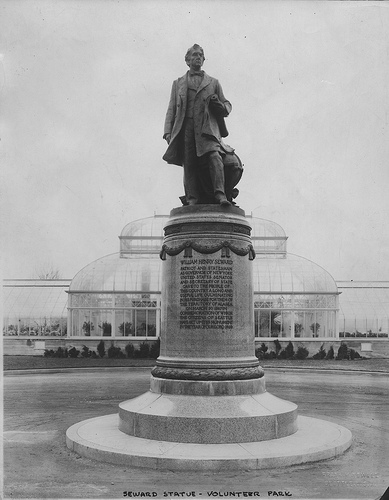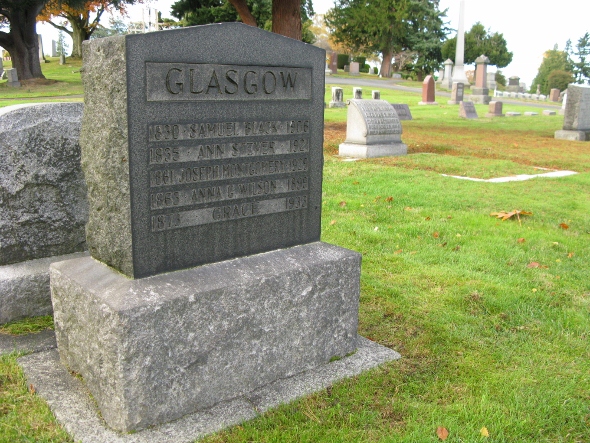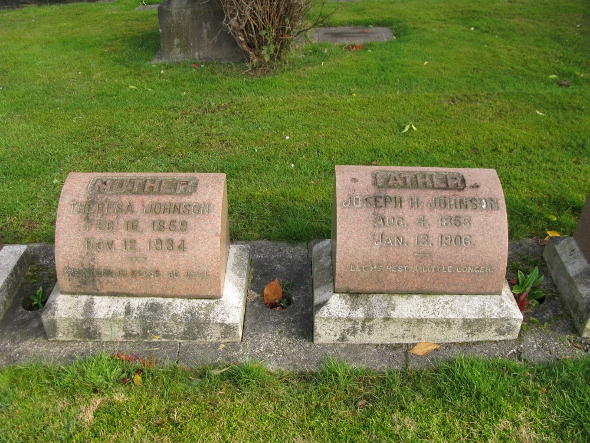Like a good wine, Volunteer Park gets better with age.
The conservatory — about to celebrate its centennial — is exploding with life. The starters and seedlings that the Olmsted Brothers planted from 1903 and 1909 have grown into towering beauties with full, colorful forms.
The park is a perennial favorite for strolling and wandering. Here, a couple are gazing up at the 1909 statue of William Seward. It was created for the Alaska Yukon Pacific Exposition and moved to Volunteer Park right after the fair closed. Do you remember the phrase “Seward’s Folly” from US History class back in high school? This is the guy who bought Alaska from the Russians. Seattle got rich off the gold rushes, and this is where you should go to thank him.
 Scene in 1912 or 1914 (Image: Seattle Municipal Archives)
Scene in 1912 or 1914 (Image: Seattle Municipal Archives)
Afterwards, you can walk over to Lake View Cemetery and thank the people who put that gold to use. The cemetery is right behind the conservatory, though it’s a bit of a walk around to the entrance. Lake View was started in 1872 as a Masonic cemetery, and bills itself as “Seattle’s Pioneer Cemetery”. Yeslers, Dennys, Dearborns, Burkes — all of the famous names from Seattle’s early history are here. It was also the neighborhood cemetery for Capitol Hill, and many early residents are buried alongside the pioneers. Remember, Capitol Hill was settled 40 years after Alki and Pioneer Square.
Try searching for a last name in the directory. If you get results, email the cemetery staff or drop by the office on weekdays to get a map to the burial site. For this article, the staff emailed PDF scans of old maps showing the location of Glasgow family featured in Hidden Stories of Love and the Johnson family from Martian Pipeline Posse on Broadway.

 When you visit, keep your eyes open. You never know whose grave you might see when visiting a new section. Case in point: right next to the Johnson family is a large “Thomson – Porep” marker. This commemorates R. H. Thomson and his son-in-law Edward Porep. Thomson was the “shaper of Seattle”, the city engineer responsible for all of Seattle’s regrades as well as the Cedar River water supply pictured last time.
When you visit, keep your eyes open. You never know whose grave you might see when visiting a new section. Case in point: right next to the Johnson family is a large “Thomson – Porep” marker. This commemorates R. H. Thomson and his son-in-law Edward Porep. Thomson was the “shaper of Seattle”, the city engineer responsible for all of Seattle’s regrades as well as the Cedar River water supply pictured last time.
William Wilson points out in Shaper of Seattle that Thomson lived at 955 Thirteenth Avenue East, only a few yards from Volunteer Park. His family moved there in 1909, just before the Seward statue was installed. They left for Victoria, B.C. after a few years when Thomson gave up on Seattle. But this period — 1909 to 1915 — coincides precisely with the arc of the Plan of Seattle, Virgil Bogue‘s failed masterpiece.
Thomson varyingly is credited with getting Bogue the job or perhaps being the ghost writer of the plan. You have to wonder then, what impact did R. H. Thomson’s Capitol Hill to city hall commute have on the plan’s schemes for our neighborhood? Hold that thought – we’ll be exploring some of the amazing ideas in this column in the near future.
Local history expert Rob Ketcherside shares his vision of the past and present with his Re:Take series of works on CHS and other Seattle sites.



